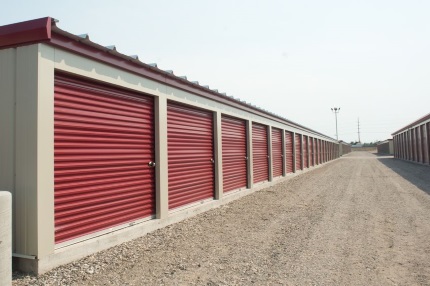Self-storage real estate investment trusts (REITs) own, operate, and manage mini-warehouse storage facilities at which people pay to store items they do not need immediately, but do not want to discard.
Recently, investors have not stored these shares for safekeeping in their portfolio. Instead, they have sent the stocks of self-storage operators straight to the trash dump.

Since hitting a record high in April, Public Storage (PSA), the country’s largest self-storage owner, has experienced a stock collapse of 20%, reducing its market value to less than $59 billion.
Its smaller rivals Extra Space Storage (EXR), CubeSmart (CUBE), and Life Storage (LSI) have all fallen by a similar percentage or more.
This is quite a comedown!
According to Nareit data, self-storage REITs achieved a return of nearly 60% in 2021, the highest among all REIT sectors.
Why the recent dramatic drop? Let’s take a look at the REIT sector.
Self-Storage REITs
Self-storage properties are one of the lowest-cost real estate investments because they’re inexpensive to build and operate. As a result, they also tend to have relatively low occupancy break-even rates. These factors enable self-storage investments to generate high margins and investment returns.
In addition, most self-storage units rent on a month-to-month basis, differing from the lease structure of many other REITs, which typically own properties that lease space for a year or more. This shorter-term lease structure enables self-storage REITs to raise rents more frequently. But, in weak markets, they might have to reduce rents more quickly.
In addition to generating rental income, self-storage REITs have several other potential revenue sources, depending on their business model. These may include tenant reinsurance, management fees, late fees, and the sale of moving materials (boxes, packaging, tape, etc.).
Self-storage REITs benefited greatly from rising demand for storage space during the coronavirus pandemic. The rise of remote work during the early days of social distancing led to an increase in the migration of people seeking more affordable locations and a higher quality of life.
This migration, in turn, created new demand for self-storage space in markets across the U.S. The national average for 10-foot x 10-foot climate-controlled unit rental rates increased by nearly 10% last year, with markets in the Sun Belt reporting year-over-year increases as high as 15%.
However, self-storage REITs are not without risk, including one notable sector-specific risk: Because self-storage facilities are cheap to build and operate, there are low barriers to entry. Developers can quickly build new capacity. This can increase competition for customers in a market, weighing on occupancy levels and rental rates at existing facilities. This was a major problem before the pandemic.
In addition to that sector-specific risks, self-storage REITs face two potential headwinds that all REITs face: interest rate risk and financing risk.
As interest rates rise, borrowing money becomes more expensive. If an REIT has lots of floating rate debt or near-term maturities, rising rates can increase its interest expenses. Higher interest rates can also impact an REIT’s ability to finance acquisitions and development projects.
Finally, a higher interest rate environment makes the relatively high dividend yields generated by REITs less attractive. This leads to drops in stock prices like the ones we’ve been seeing since April. Of course, this has only served to create an opportunity for investors to buy the leader in the sector, Public Storage, at a reasonable price.
Public Storage
As of the end of 2021, Public Storage had 2,787 self-storage facilities in the U.S., with 193 million square feet of rentable space, as well as a 35% equity stake in Shurgard Europe, which has 253 facilities and 14 million square feet of rentable space.
Here in the U.S., the company has self-storage properties in 35 states, with 41% of these properties located in California, Texas, and Florida. That’s a main reason why Public Storage has the highest occupancy rates in the industry.
Keep in mind that California is projected to remain the country’s largest state, population-wise, while Texas and Florida are expected to post significant population growth exceeding the national average, thanks to domestic migration from other states.
Roughly 18% of Public Storage’s square footage is in California, with attractive, high-quality facilities and limited competition. It benefits from highly restrictive zoning regulations, preventing the addition of new supply. Approximately 26% of the company’s net operating income derives from self-storage facilities in Los Angeles and San Francisco alone. Public Storage currently has a more than a 20% market share in Los Angeles and San Francisco, considerably higher than its next-largest peer in those cities.
Public Storage does plan to sell its interest in joint venture PS Business Parks (PSB) to Blackstone Real Estate in the third quarter of this year. The sale will cut annual core FFO (funds from operations) by about $100 million, though management expects to distribute $2.3 billion in sale proceeds to shareholders.
In summary, self-storage REITs benefit from a combination of lower costs, solid demand, and short-term lease structures. And compared with other REITs, self-storage REITs are low maintenance. They do not have to spend a lot of money to keep their customers happy.
Demand for self-storage is holding up and seems not to be easily swayed by macroeconomic trends.
Public Storage, for example, reported occupancy of more than 95% in its latest quarter! Its revenue, margins and net operating income all rose during the period.
Even the biggest problem for the self-storage sector—oversupply—appears to be on the decline. In 2021, there was less self-storage facility development than in 2019. The total development value was $3.5 billion in 2021, versus $5 billion in 2019.
Public Storage has averaged a dividend payout ratio of 75% of adjusted FFO over the past several years, which strikes me as being an appropriate level for an REIT. I believe that the company will continue to grow its dividend over the next few years to maintain this level of payout.
Take advantage of the recent drop in its stock price and buy Public Storage in the $310 to $340 price range.





